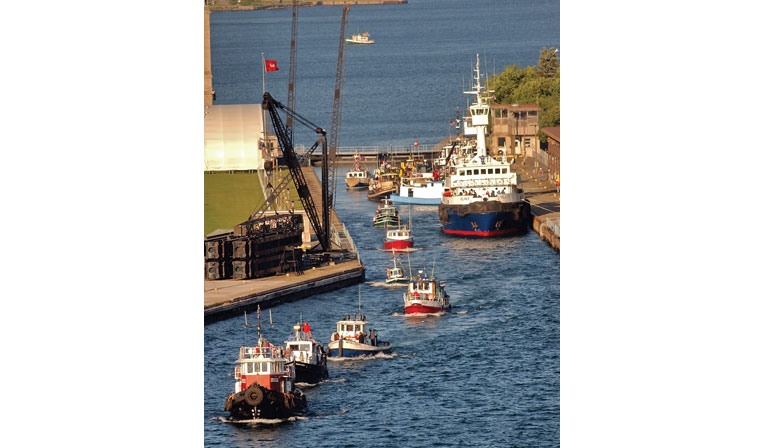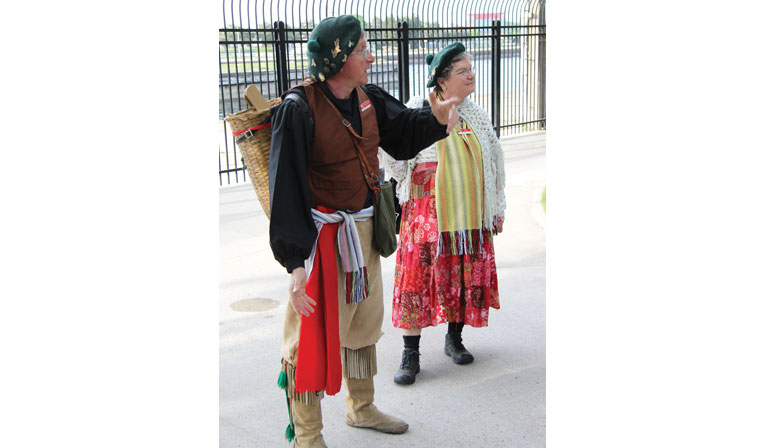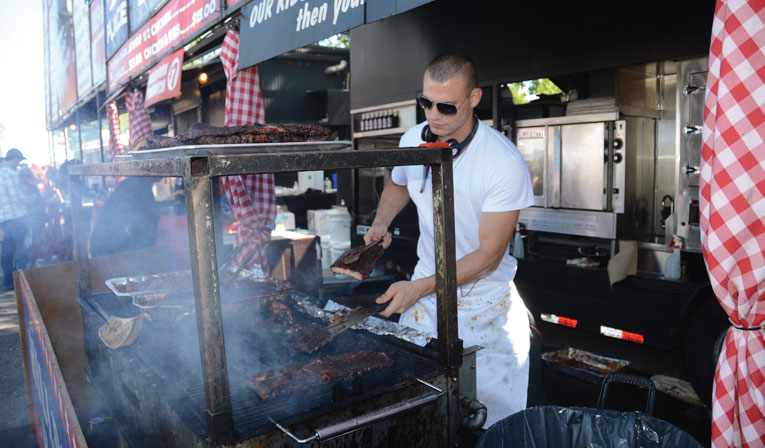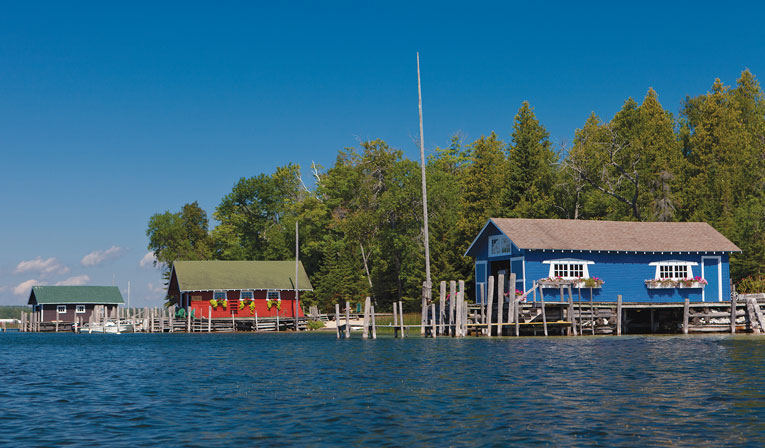Photo courtesy of Tourism Sault Ste. Marie/saulttourism.com
The twin communities of Sault Ste. Marie, Michigan and Sault Ste. Marie, Ontario offer visiting boaters the best of both countries.
I’m meandering along Dock 1, en route to the Soo Locks Boat Tours’ Le Voyageur, when a muskrat swims past and darts playfully under the slats. This would be fun as just an isolated wildlife moment, but this day, in this spot, it feels like serendipity.
My friend and I look at each other and laugh. Earlier in the day, we’d playfully donned a couple of the fur hats with tails at souvenir shops with names like Mocs du Locke and Ships Ahoy. And now we could almost imagine ourselves as contemporaries of the fur traders we’ve been learning about in history exhibits around the region — those like young Frenchman Etienne Brule, who first stumbled upon what would later become the twin international cities of Sault Ste. Marie, Michigan and Sault Ste. Marie, Ontario, about the same time the Mayflower Pilgrims landed at Plymouth Rock. It was nice to see that not everything has changed since, even though many things clearly have.
The need to portage around the 21-foot waterfall that once thundered down the depth difference between Lake Huron and Lake Superior has been eliminated by the area’s biggest tourist draw: The Soo Locks. Dugout canoes and early lake schooners, once rolled on logs down aptly named Portage Avenue, have been replaced by ocean-going freighters carrying some 80 million tons of mostly iron ore each year. And an increasingly international population has brought a thriving ethnic dining scene to Sault Ste. Marie Canada, while even staples like whitefish and venison are getting an increasingly gourmet twist across the area locals affectionately call the “Soo.”
But you’re right where you feel you belong when you enter by water and dock for a stay in the marina. Life remains centered on the St. Marys River passage, around freighters and fish and a past that seems to never have left, not with history so ever present in museums-inside-freighters, atop towers, inside historic homes, and shared on kiosks along waterfront walkways. And there’s still more than a little of that North that greeted those initial explorers, evidenced by the visiting muskrat, thriving fisheries and the moose that just may cross your path as you head north along Canada’s scenic Highway 17.
“We say life here is about drinking in the atmosphere; of looking up at the sky to see that night sky with the stars and the beauty, or to walk a trail and to think of those a thousand years earlier who walked it before you,” says Cecil Pavlat, a cultural affairs expert with the Sault Tribe of Chippewa Indians and lifelong resident. “It is the center of the Great Lakes, and it always has been.”

Photo courtesy Sault Ste. Marie Visitors Bureau/saultstemarie.com
Things to do in Sault Ste. Marie
 Breakfast on a Barge (late June) is a highlight of the annual Great Tugboat Race (end of June).
Breakfast on a Barge (late June) is a highlight of the annual Great Tugboat Race (end of June).
Soo Locks Engineer’s Weekend (late June) opens generally closed areas of the locks to the public within a festive party weekend.
Sault Tribe Powwow and Summer Gathering (second week of July) celebrates the history of tribal gatherings in the Soo with clothing and dances of spiritual significance.
Rotaryfest (mid-July) offers street entertainers, barbecue, carnival rides and more in Sault Canada’s main summer festival.
Rendezvous in the Sault (last weekend of July) draws reenactors from around the country to the Sault Michigan waterfront to showcase 18th century military and civilian life with hands-on exhibits.
1812 Rendezvous (Sept. 18-21) will commemorate the War of 1812 and fur trade era in a special event at Sault Canada’s Ermatinger-Clergue National Historic Site, within walking distance from the marina.
Bushplane Days (Sept. 19-21) celebrates aviation and forestry history with fly-by waterbombing demos, chartered helicopter flights and more.
Sault International Marathon (Sept. 27) offers some 500 runners the chance to traverse the Sault Ste. Marie International Bridge and also run along the St. Marys River.
Bon Soo (Feb. 7-16, 2015) is Ontario’s largest winter carnival, featuring carved snow slides, a polar bear swim and more.
I-500 Snowmobile Race (Feb. 7, 2015) offers NASCAR-style thrills on ice in one of the worlds largest snowmobile races.
Boat Tours: The Soo Locks Boat Tours take you through both the American- and Canadian-side locks, with narration about local history and industry, or try the special themed dinner or lighthouse cruises. www.soolocks.com; 800-432-6301
Twilight Walking Tours: Pick the history or ghost theme (but know they claim to have had ghosts join in now and then!) on tours led by guides in period costume. www.twilightwalkingtour.com; 906-432-6301
Locking Through: Recreational vehicles (but not PWC or canoes/kayaks) are welcome to use the main Soo Locks. Contact the lockmaster on Channel 14, with the call Wue21, and be sure you have a rope of at least 75 feet on board. For freighter watching, call the boat schedule hotline to see which vessels are arriving and when. 906-253-9290.
Travel Information: Sault Ste. Marie, Michigan, www.saultstemarie.com; Sault Ste. Marie, Canada, www.saulttourism.com; Michigan’s Upper Peninsula, www.uptravel.com.
Photo by Kim Schneider
Photo courtesy of Tourism Sault Ste. Marie/saulttourism.comD
Tour du locke
With a 5-second blast signaling our tour start, Captain Clayton Hill steers Le Voyageur from the dock, muskrat no longer in sight. The sky is blue and cloudless, and the St. Marys River stretches out long and natural in one direction, toward an imposing set of manmade locks and bridges in the other. He hangs back, waiting for the 1,000-foot freighter, Paul R. Tregurtha, to pass. He playfully shouts “What’s for dinner?” and then skillfully negotiates his way around a particularly busy river channel, passing close enough so that you almost expect Tregurtha’s crew to pass over a dinner plate.
Shorelines are impressive, too, with the massive sandstone buildings constructed out of material dug up during lock construction dominating the American side, and a more recreationally-focused viewscape of sweeping pavilion tents and green space dotting the Sault Canadian side, as the ship’s narrator shares the short version of the region’s history.
Native Americans, the first to gather here, named it Bawating, or “place of the rapids.” The plentiful fish would draw tribes from around the Great Lakes during spawning, and they’d renew friendships and feast. Early fur traders renamed it Sault de Gaston (rapids of Gaston) after the brother of the French king, a fitting name, we decide, since furs made traders a kingly ransom. By the year 1800, the value of beaver skins carried through the Sault by the Northwest Fur Company was estimated at $1 million. Father Jacques Marquette tweaked the name a bit when, in 1668, he founded and christened Michigan’s first official settlement (and one of Ontario’s first), Sault Ste. Marie after the Virgin Mary, and the name stuck.
It was tricky to portage canoes around the rapids, and a short-lived Canadian canoe lock helped for a while. But it was an almost Herculean task to portage early steamers and paddlewheelers, vessels that had to be lifted atop greased timbers and pulled ever so slowly by oxen and mules. And the eventual solution — a lock system with more daily capacity than any other in the world — wasn’t easy to come by.
Political opponents claimed that a lock in the wild Upper Peninsula made as much sense as a lock on the moon, historians say. And while the charisma of a young salesman named Charles Harvey prevailed, it wasn’t without cost, as a cholera epidemic claimed the lives of many Irish laborers during construction.
The result, though, is the center of international commerce that we enter slowly to the clicking of cameras from every side of our tour boat. A deck hand tosses up a rope — way up — to a deck hand at the top of the wall. As if like magic, the Lake Superior water pouring in (it takes 10 million gallons of water to raise a boat in our MacArthur Lock, 22 million to raise the larger Poe Lock) noticeably lifts us out of what initially feels like a pit. Within 15 minutes, the gate is opening and we’re heading on our way.
We pass an impressive steel plant operation, again seemingly close enough to touch the machinery, before heading on to another lockage — this one on the Canadian side. These locks, used mostly by recreational traffic, feel more park than military complex, with the security gates of the larger Soo Locks replaced by bike trails and flower gardens. The park is a popular way to access the salmon bounty of the remaining rapids, fly rod in hand, notes Ian McMillan, executive director of Tourism Sault Ste. Marie. Ernest Hemingway wrote about this spot once, he points out, famously saying in an August 1920 piece in the Toronto Star Weekly: “The best rainbow fishing in the world is the Rapids at the Canadian Soo.”
The popularity of the city’s fishing packages today, McMillan notes, indicates the claim is likely still true.

Photo by Bill Howe
The Canadian Soo
A slip in either municipal marina is the ideal spot around which to center a trip. City attractions have even been designed around them, or built in. Sault Ontario’s 45-slip Roberta Bondar Marina, named for Canada’s first woman in space and Sault resident, is carved out of a stunning waterfront park by the same name and bordered by both a museum ship, the former passenger ferry Norgoma, and the massive pavilion, recognizable from the water by its flowing white circus-tent-like top. Boaters have a front-row seat to events like regular Wednesday night concerts that alternate between folk, rock, country and jazz.
Walk the city’s 5-kilometer waterfront boardwalk about 200 yards, and you’re at one of Ontario’s largest shopping malls, a little further to reach the Canadian Bushplane Heritage Center — a must-visit former airplane hangar devoted to the history of floatplane flying and aerial firefighting, technology that was invented here. Don’t miss the chance to climb into an old vintage plane or fight a fire via the virtual flight simulator.
More virtual history awaits at the Ermatinger-Clergue National Historic site’s exhibits related to the War of 1812 and fur trade, shared by interpreters in period costume.
Right at the pavilion, find fresh and local produce for dinner; the Algoma Farmer’s Market is held here, or enjoy some chowder with your view at the View Restaurant & Bar, in the Delta Sault Ste. Marie Waterfront Hotel and Conference Centre at the marina. Follow the boardwalk west, past carved sculptures, to reach the Sault Ste. Marie Canal National Historic Site at the Canadian locks, where a bikeable nature trail winds around South St. Marys Island. The area’s first lock was actually built here, completed in 1798 as a canoe lock, destroyed during the War of 1812, then eventually rebuilt.
On this side of the river, the culinary scene has a distinctive international bent. The region’s strong Italian heritage is likely to mean handmade pasta and slow-cooked sauces at Italian favorites like Cesira’s Italian Cuisine. Or vary the menu with traditional Indian, Japanese or Korean. Just leave a day open for a trip on the Agawa Canyon Train, a one-day, 114-mile journey into a canyon that leaves from a depot within walking distance, past three sets of waterfalls. It’s particularly striking in autumn.
The American twin
Like its Ontario counterpart, the George Kemp marina is bordered by a museum-in-a-ship — in this case, the world’s largest museum ship, the Valley Camp. Here, find an aquarium of Great Lakes fish, displays on ships and shipwrecks, and an eerie highlight in Cargo Hold 2: The battered lifeboat from the Edmund Fitzgerald.
Those three houses directly behind the marina are museums, too — homes staffed by docents in peak summer and highlighting the history of the original home owners, John Johnson, Henry Schoolcraft and the beloved Bishop Baraga, a sainthood candidate known as the “snowshoe priest” for the way he traveled among his flock.
The town’s most visible landmark, the 210-foot-tall Tower of History, built to honor early missionaries, doubles as a museum and view tower. From its top, see if the region doesn’t resemble a complicated model train set as you gaze out over those four parallel locks, the hydroelectric plant and both a railroad and international bridge in the distance.
The two-story platform at the Soo Locks Visitor Center, run by the U.S. Army Corps of Engineers, is not quite as tall, but you can’t get much closer than this to passing freighters. A watch board inside, regularly updated, also is a popular way to plan a day around spotting of some of the 7,500 cargo carriers and recreational vessels that lock through each year, bearing flags of countries from around the world.
Or watch from across Portage Avenue, perhaps while enjoying fresh whitefish and chips at the nautical-themed Lockview Restaurant. More serendipity may come as you’re using a wooden salt shaker replica of the Mesabi Miner and the real ship comes through the lock in front of you, hauling a load of iron ore from Duluth.
The town’s quirky personality is maybe best exemplified at Antler’s Restaurant, a so-called “taxidermy orphanage” in which 302 mounts of the likes of a wolverine, lion and polar bear decorate ceilings and walls. Burger buns are fresh baked and planked whitefish fresh caught, but you have to sample the American/Canadian fusion dish that aptly connects the city twins: A venison poutine made with handcut fries, Wisconsin cheese curds, homemade beef gravy and more.
Just get back to the center of town before sunset. Hit shops like Riverstone Gallery, where Yooper ingenuity has led to wall sculptures and clocks made from discarded motherboards and jewelry crafted from filmstrips and camera lenses, and toast to your trip with a Super Yooper IPA at the Soo Brewing Company. Then be sure to glance west as the sky turns its many evening shades of deep pink and purple, and a freighter in the lock approach is so close that it appears to be portaging straight down Portage Avenue.
As locals like to say, boat lovers are nothing but lucky here. Their ship is always about to come in.
Take a “Great Waters” Road Trip
 The Eastern Upper Peninsula of Michigan has coined the phrase “The Great Waters” for the way you can dip your toes in three of the Great Lakes — Superior, Huron and Michigan — in the course of an easy day trip. Many of the way stops are worthy destinations on their own.
The Eastern Upper Peninsula of Michigan has coined the phrase “The Great Waters” for the way you can dip your toes in three of the Great Lakes — Superior, Huron and Michigan — in the course of an easy day trip. Many of the way stops are worthy destinations on their own.
Whitefish Point: That you probably know this locale by its notable mention in the Gordon Lightfoot song, “The Wreck of the Edmund Fitzgerald,” is a good reason to visit by car, not boat, most especially in a November gale. A display featuring the Edmund Fitzgerald’s bell is just one highlight of the Great Lakes Shipwreck Museum on the point. Pair it with a beachgoing and birding trip. The sandy point forms a migration funnel that attracts both songbirds and raptors by the thousands. Booking a room at the remodeled Coast Guard Crews Quarters-turned-B&B makes it easy to also observe the late-night banding of owls, spring through fall. www.shipwreckmuseum.com, www.wpbo.org
Paradise: Most aptly named, particularly in mid-August at the height of the wild blueberry season or October cranberry harvest. The upper and lower Tahquamenon Falls, memorialized in Longfellow’s “The Song of Hiawatha” and colored like root beer by tannins, are striking any time of year. Hiking and canoe trails are popular in temperate months, but cross-country skiing and snowshoeing are great ways to see the falls in their dramatic frozen state. www.paradisemichigan.org
Hessel and the Les Cheneaux Islands: A straight shot south from Sault Ste. Marie. Book a paddling trip with Woods and Water Ecotours to explore the nature around the mostly private islands, dotted with colorful boathouses, and the full moon and sunset kayak options add a special twist. If the timing works, the Great Lakes Boat Building School offers accessible weekend classes, and the antique wooden boat show each August highlights craftsmanship and the area’s boat heritage. www.woodswaterecotours.com
Detour/Drummond Island: Pick up the ferry in Detour, and there’s plenty to explore on the nation’s second largest freshwater island. Enjoy golf (27 holes), shipwrecks (17), rare plant and bird life, and a massive system of often challenging offroad trails. www.drummondislandchamber.com
Photo Courtesy of the Les Cheneaux Chamber of Commerce


